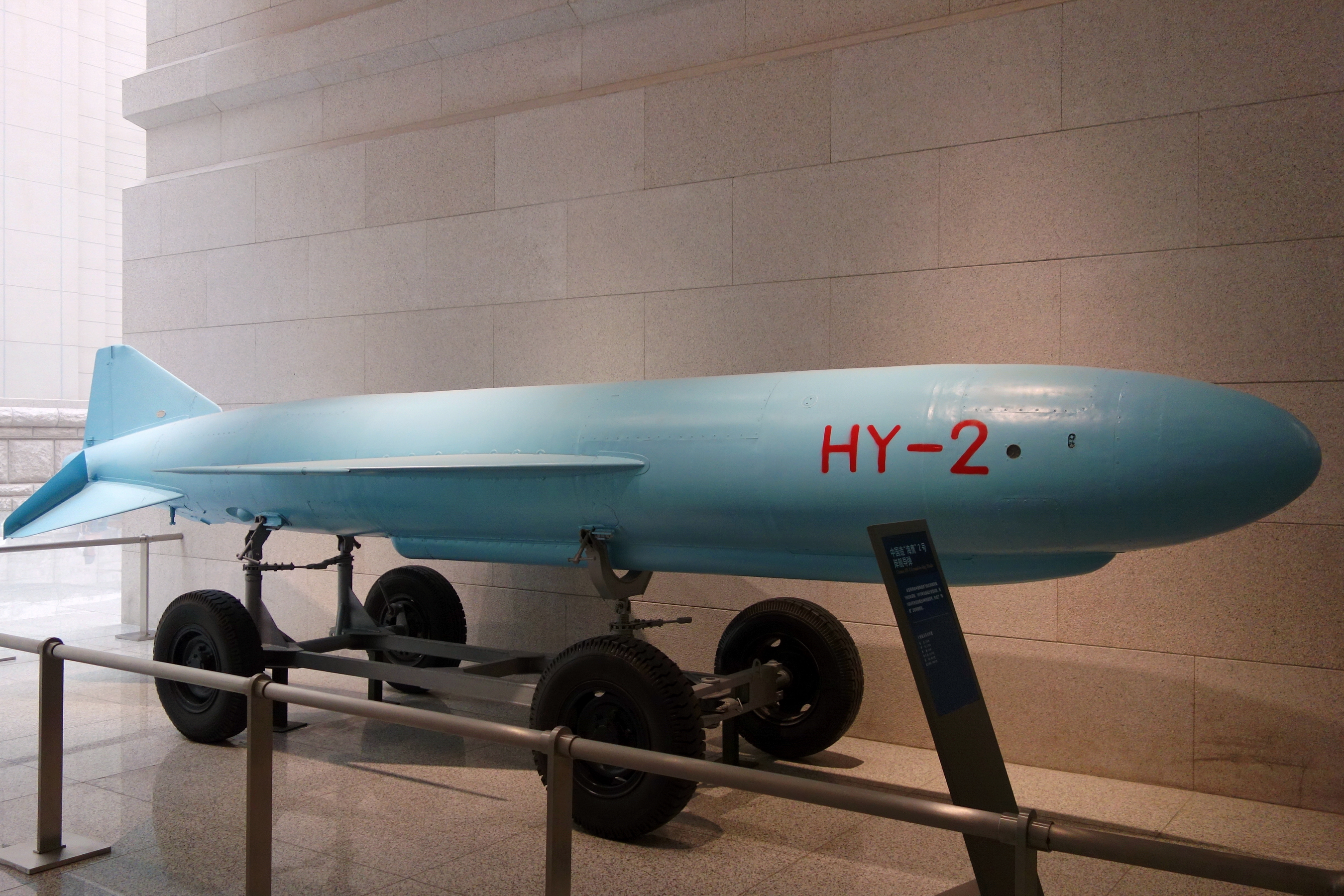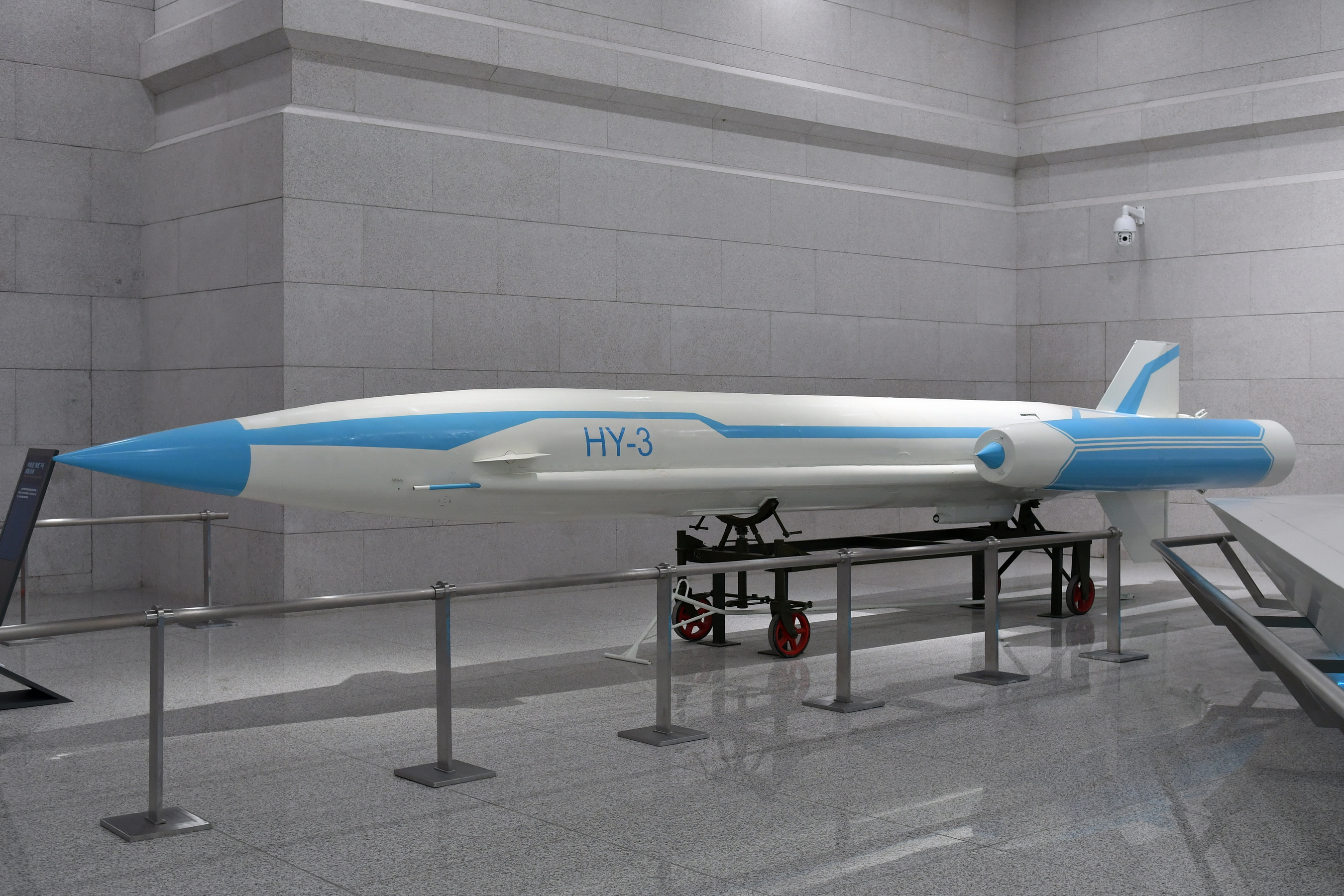HY-2 Haiying on:
[Wikipedia]
[Google]
[Amazon]
The SY (), and HY () series were early

 Chinese preparations were underway before receiving the first P-15s and related technical data from the Soviets in 1959. On 8 October 1956, the
Chinese preparations were underway before receiving the first P-15s and related technical data from the Soviets in 1959. On 8 October 1956, the
. June 23, 1997.

Federation of American Scientists page on HY-1
{{Chinese Missiles Anti-ship cruise missiles of the People's Republic of China China–Soviet Union relations Guided missiles of the People's Republic of China
anti-ship cruise missile
An anti-ship missile (AShM) is a guided missile that is designed for use against ships and large boats. Most anti-ship missiles are of the sea skimming variety, and many use a combination of inertial guidance and active radar homing. A good ...
s (ASCM) developed by the People's Republic of China from the Soviet P-15 Termit missile. They entered service in the late 1960s and remained the main ASCMs deployed by the People's Liberation Army Navy
The People's Liberation Army Navy (PLAN; ), also known as the People's Navy, Chinese Navy, or PLA Navy, is the maritime service branch of the People's Liberation Army.
The PLAN traces its lineage to naval units fighting during the Chinese ...
through the 1980s. The missiles were used by the PRC and export customers to develop land-attack missiles.
The name Silkworm is popularly used for the entire SY and HY family. As a NATO reporting name
NATO reporting names are code names for military equipment from Russia, China, and historically, the Eastern Bloc (Soviet Union and other nations of the Warsaw Pact). They provide unambiguous and easily understood English words in a uniform manne ...
it applies only to the land-based variant of the HY-1.
Development

 Chinese preparations were underway before receiving the first P-15s and related technical data from the Soviets in 1959. On 8 October 1956, the
Chinese preparations were underway before receiving the first P-15s and related technical data from the Soviets in 1959. On 8 October 1956, the Fifth Academy The Seventh Ministry of Machine Building (第七机械工业部), originally the Fifth Academy of the Ministry of National Defense, was a government ministry of the People's Republic of China, established November 23, 1964 by the State Council to ov ...
was founded - with Qian Xuesen as director - to pursue missile development, and in March 1958 a cruise missile test site was selected at Liaoxi
Liaoxi () was a former province in Northeast China, located in what is now part of Liaoning and Jilin provinces. It existed from 1949 to 1954, and its capital was Jinzhou
Jinzhou (, ), formerly Chinchow, is a coastal prefecture-level city ...
in Liaoning
Liaoning () is a coastal province in Northeast China that is the smallest, southernmost, and most populous province in the region. With its capital at Shenyang, it is located on the northern shore of the Yellow Sea, and is the northernmost ...
. The first successful missile test was conducted in November 1960 after the withdrawal of Soviet advisors in September due to the Sino-Soviet split. The P-15 was copied to became the SY-1. Production started at the Nanchang Aircraft Manufacturing Company
Nanchang (, ; ) is the capital of Jiangxi Province, People's Republic of China. Located in the north-central part of the province and in the hinterland of Poyang Lake Plain, it is bounded on the west by the Jiuling Mountains, and on the east ...
in October 1963 and the first successful test occurred in 1965; production was approved August 1967 and the SY-1 entered service by the end of the decade.
The SY-1 was developed into the improved HY-1; the HY-1 was successfully tested in December 1968 and entered service in 1974.
Operational history
Iran–Iraq War
The Silkworm gained fame in the 1980s when it was used by both sides in the Iran–Iraq War; both countries were supplied by China. During 1987, Iran launched a number of Silkworm missiles from the Faw Peninsula, striking the American-owned,Liberia
Liberia (), officially the Republic of Liberia, is a country on the West African coast. It is bordered by Sierra Leone to Liberia–Sierra Leone border, its northwest, Guinea to its north, Ivory Coast to its east, and the Atlantic Ocean ...
n-flagged tanker ''Sungari'' and U.S.-flagged tanker ''Sea Isle City'' in October 1987. Five other missiles struck areas in Kuwait earlier in the year. In October 1987, Kuwait's Sea Island offshore oil terminal
An oil terminal (also called a tank farm, tankfarm, oil installation or oil depot) is an industrial facility for the storage of oil, petroleum and petrochemical
Petrochemicals (sometimes abbreviated as petchems) are the chemical products obt ...
was hit by an Iranian Silkworm which was observed to have originated from the Faw peninsula. The attack prompted Kuwait to deploy a Hawk missile battery on Failaka Island to protect the terminal. In December 1987, another Iranian Silkworm was fired at the terminal, but it struck a decoy barge instead. Prior to these attacks the missile's range was thought to be less than , but these attacks proved that the range exceeded with Kuwaiti military observers seeing that the missiles originated from the area and tracking them on radar along with US satellite imagery of the launch sites.Counter-memorial and Counter-claim submitted by the United States of America. June 23, 1997.
Persian Gulf War
On February 25, 1991 during Operation Desert Storm, a shore-based Iraqi launcher fired two Silkworm missiles at the USS ''Missouri'' which was in company with the USS ''Jarrett'' and HMS ''Gloucester''. A Sea Dart missile from HMS ''Gloucester'' shot down one Silkworm and the other missed, crashing into the ocean. Royal Air Force officers subsequently recovered an HY-2 missile at Umm Qasr in southern Iraq. It is currently displayed at the RAF Museum Cosford.Iraq War
During the2003 invasion of Iraq
The 2003 invasion of Iraq was a United States-led invasion of the Republic of Iraq and the first stage of the Iraq War. The invasion phase began on 19 March 2003 (air) and 20 March 2003 (ground) and lasted just over one month, including 26 ...
, Iraq used the Silkworm (HY-2 Seersucker) as a surface to surface missile
A surface-to-surface missile (SSM) or ground-to-ground missile (GGM) is a missile designed to be launched from the ground or the sea and strike targets on land or at sea. They may be fired from hand-held or vehicle mounted devices, from fixed ins ...
by firing at least two of them at the coalition positions in Kuwait.
Variants
;SY-1 License produced version of the P-15 Termit. NATO reporting name CSS-N-1 Scrubbrush. ;SY-2 ;HY-1 NATO reporting names CSS-N-2 Safflower(ship-based) and CSSC-2 Silkworm (land-based.) ;HY-2 NATO reporting names CSS-N-3 Seersucker(ship-based) and CSSC-3 Seersucker (land-based.) ;HY-3 Unsuccessful supersonic variant. ;HY-4 Powered by a WP-11 turbojet, a reverse-engineered Teledyne-Ryan J69-T-41A. Used for LACM development. NATO reporting name Sadsack. ;YJ-63 Air-launched LACM sharing visual characteristics of the HY-2, HY-4, and YJ-6. 200 km range. ;AG-1 Longer-ranged variant of the HY-2 developed by North Korea.Operators

Current operators
* (made under license) * ( Type 053H) * * * (as of Saddam's Era) * * * *References
Sources
* *External links
Federation of American Scientists page on HY-1
{{Chinese Missiles Anti-ship cruise missiles of the People's Republic of China China–Soviet Union relations Guided missiles of the People's Republic of China